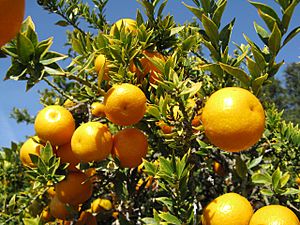Myrtle-leaved orange tree facts for kids
Quick facts for kids Myrtle-leaved orange tree |
|
|---|---|
 |
|
| Chinotto oranges growing on a tree | |
| Scientific classification |
The myrtle-leaved orange tree is a special type of Citrus plant. It's also known by its Italian name, chinotto. This tree gets its name because its leaves look a lot like those of the common myrtle plant.
The chinotto tree is quite small and compact. It doesn't have thorns, which makes it friendly to handle. Its fruits look like tiny oranges. They have a bitter taste and are very important for flavoring many Italian drinks and foods.
The Chinotto Orange Tree
What Does It Look Like?
The myrtle-leaved orange tree is a small plant. It usually grows to about 3 meters (10 feet) tall. Its leaves are small and shiny, similar to the myrtle plant. This compact size means it can fit well in many gardens. It can even grow in a pot or other container.
Where Does It Grow?
This unique citrus tree is mostly found in certain parts of the world. You can see it growing in Malta and Libya. It also grows in the south of France. However, it is most common in Italy. In Italy, you'll find it mainly in areas like Liguria (especially Savona), Tuscany, Sicily, and Calabria.
What Are Its Fruits Used For?
The small, orange-like fruits of the chinotto tree are very famous. They are known for their bitter flavor. This special taste makes them a key ingredient in many popular Italian products.
For example, chinotto fruit is used to flavor most Italian amari. These are bitter herbal liqueurs. It's also a main ingredient in the well-known Campari apéritif. Many carbonated soft drinks are also made with chinotto. These drinks are often just called "chinotto" drinks.
Growing Chinotto Trees
Because of its small size, the myrtle-leaved orange tree is a popular choice for gardens. It's also great for growing in pots. This means you can enjoy its unique look and fruits even if you don't have a lot of space. It adds a touch of Mediterranean beauty to any area.
Images for kids
-
A sour chinotto orange at the Missouri Botanical Garden.
See also
 In Spanish: Naranjo moruno para niños
In Spanish: Naranjo moruno para niños



